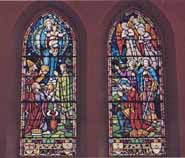In 1937, Reverend Bull built a mortuary chapel in the church cemetery and on January 30, 1938, the chapel was officially named the Chapel of the Resurrection. This chapel went on to establish its own congregation and officially became a separate parish in 1951. Sadly, Reverend Bull died as a result of blood poisoning two years later on January 30, 1940.
On July 7, 1940, twenty-eight year old Philip Rodger Beattie became the new rector for the Church of the Epiphany. During this time, war was once again upon the world and as with the previous World War, parish numbers  were in decline. Reverend Beattie would pay visits to Anglican families who were new to the area in an effort to help increase the number of active parishioners.
were in decline. Reverend Beattie would pay visits to Anglican families who were new to the area in an effort to help increase the number of active parishioners.
Despite the hardships faced by the parish, it was determined in 1941, that a church hall was needed. A building fund was established and on March 6, 1942, the hall was completed and officially opened.
Reverend Beattie, wanting to contribute to the war effort, left his parish to become chaplain for the R.C.A.F., leaving appointed deacon, William Robert Coleman, as priest-in-charge. Upon Reverend Beattie's return eighteen months later, deacon Coleman resigned as parish priest to pursue a career in academics. Reverend Beattie resigned in 1948 and later died in 1960.
Five years after the end of the war, on June 12, 1950, a commemorative window was installed in the Church of the Epiphany in honour of those parishioners who did not return from the war. A memorial plaque listing the names of the dead was created and kept within the church.

 Greater Sudbury Guestbook
Greater Sudbury Guestbook
 Home Page
Home Page
 Greater Sudbury Histories
Greater Sudbury Histories
 Church Improvements
Church Improvements



